Reviews by Eloquence
Ken Liu’s short story The Paper Menagerie was the first work of fiction to pick up the Nebula, the Hugo and the World Fantasy Award at the same time—deservedly so, as it is a moving and imaginative story that harmonizes with the author’s strengths, weaving together threads of family, myth, and fantasy.
I quite enjoyed Liu’s short story collection of the same name, so I had to pick up his second collection, The Hidden Girl and Other Stories, the moment I read about it. While it held my attention, I must say that I might wait a little longer before picking up Liu’s next volume of stories.
To be fair, there are some real gems among the 19 stories assembled here. For example:
-
Ghost Days explores how memories of our culture and traditions help us hold on to a shared identity, even in a future where our species has modified its biology to adapt to other planets.
-
The Reborn takes us back to Earth, where humans are living side-by-side with aliens whose concept of self is entirely different from our own.
-
The Message is about a father connecting with a teenage daughter he has never met, in the ruins of an alien civilization.
A novella split into three stories comprises the core of the book: The Gods Will Not Be Chained, The Gods Will Not Be Slain, and The Gods Have Not Died in Vain. A young girl, Maddie, discovers that fragments of her deceased father may still be alive as a computer program. This discovery is a harbinger of a dark future in which uploaded uber-minds fight for control of the entire planet. The tale never quite finds its emotional footing, getting as lost as the world it portrays.
Liu returns to the theme of mind uploading in three stories: Seven Birthdays, Staying Behind, and Altogether Elsewhere, Vast Herds of Reindeer. I found myself waiting for some imaginative twist that justifies the inclusion of these very similar stories. Instead, I found powerful ideas rendered less potent through repetition.
This brings me to the titular story, The Hidden Girl. It’s a fantasy tale set in the Chinese Tang dynasty era, about a young girl who is abducted from home to become an assassin with mystical powers. Unfortunately, the story feels like one we’ve heard many times before, in many variants.
At 411 pages, this is a hefty collection by a prolific writer. But Liu should have taken a page from the monks in his last story, The Cutting, who reinforce their mythology by gradually erasing it. A more careful selection would have helped his gems shine more brightly. As it is, I would give The Hidden Girl 3.5 stars, rounded down for the inclusion of a promotional excerpt from Liu’s next book as its own story.
Wide Ocean Big Jacket falls into the category of game sometimes called “walking simulators” or, more generously, “narrative adventure games”. In a world rendered in simple but attractive low poly art, we are introduced to teenagers Ben and Mord, who are on a camping trip with Mord’s aunt and uncle, Cloanne and Brad.
As the player, your point of view keeps changing from one character to the next. You explore the campsite, complete small tasks like setting up the tent, and have conversations. During dialogue sequences, the game world disappears from view, and only text and a small cartoon representing the speaker are visible.
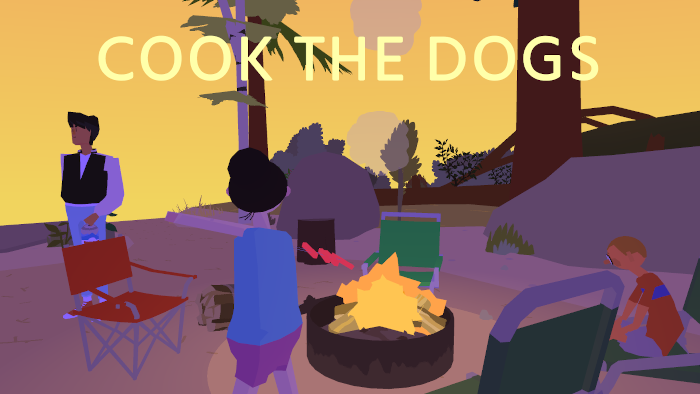
No camping trip would be complete without a campfire cooking experience. (Credit: Turnfollow. Fair use.)
It turns out that Ben and Mord are dating, and their burgeoning relationship is contrasted with Brad and Cloanne’s childless marriage. The story doesn’t build towards some dramatic conclusion or revelation—it is meant to be a “slice of life” in the moments of these characters. There’s relationship talk, birdwatching, and trashy literature.
The game succeeds at bringing Mord, Ben, Brad, and Cloanne to life in the hour or so we spend with them. It’s not a perfect experience: the writing could have used some copyediting, and the game world is so tiny as to feel limiting. The regular price of $8 is a bit high for this charming but very short journey; if you already own it thanks to The Bundle or can get it for less, I definitely recommend the trip.
The idea of cursed letters (“Send this to 10 friends or you will die”) and other artifacts of death is a common horror trope. It is also the premise of The Letter, a horror game by Philippines-based Yangyang Mobile. The game was originally crowdfunded via Kickstarter.
The Letter is set in a small fictional English city named Luxbourne. Isabella Santos, a young real estate agent, is tasked with selling the Ermengarde Mansion, a 17th century property rumored to be haunted. In the mansion, she encounters a malevolent presence that almost kills her—and she finds a cursed letter written in blood.
The game mostly plays as a fully voice-acted visual novel, but it features a few (skippable) quick time events. In each chapter, you play as a different character:
-
Isabella Santos, the young, cheerful real estate agent who discovers the letter
-
Hannah Wright, a wealthy heiress who seeks to acquire the Ermengarde Mansion
-
Luke Wright, a sleazy businessman and Hannah’s husband
-
Marianne McCollough, an interior designer hired by the Wrights
-
Rebecca Gales, a teacher; Isabella’s closest friend
-
Zachary Steele, a photographer and aspiring filmmaker; part of Isabella’s circle of friends
-
Ashton Frey, a young detective; part of Isabella’s circle of friends
You are offered choices throughout the story. Some may lead to an early death of the character you are playing, but unlock new branches of the story later. Other choices influence the relationships between the characters: Will Ashton and Rebecca become lovers, or remain friends?
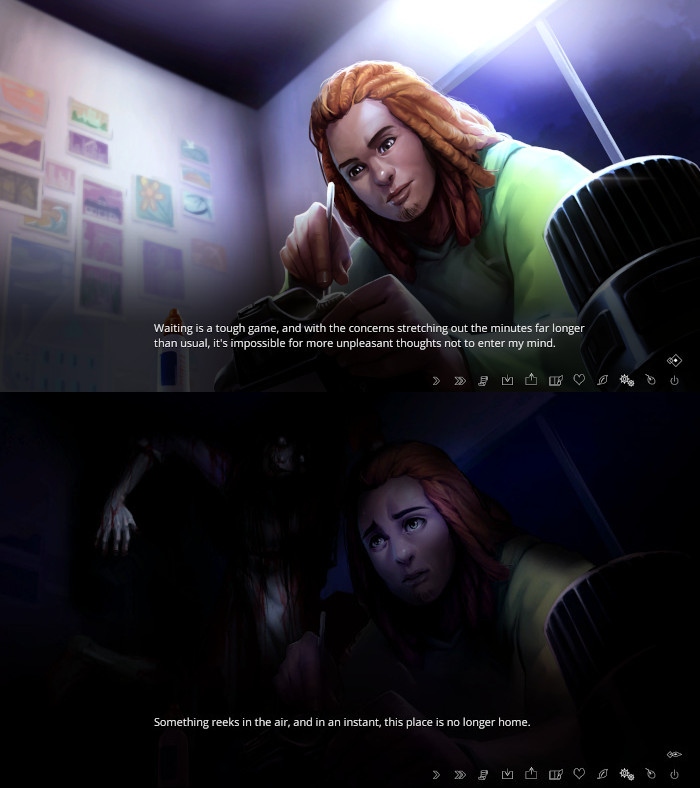
Throughout the game, everyday scenes are transformed into nightmares as Isabella and her friends are haunted by a malevolent entity. (Credit: Yangyang Mobile. Fair use.)
Show and tell, and tell, and tell
The chronology of the chapters is overlapping: you experience some of the same moments from the perspective of different characters, with their inner voice adding new layers of meaning to dialog you have already heard. A journal records significant events in the story, which is a very helpful feature if you take longer breaks between sessions.
Unfortunately, most of the characters have a tendency to blather. Where one line of inner voice text would have sufficed, we get many paragraphs of overwrought observations, recollections, and reflections. The text would have much benefited from copyediting—both to cut the fat, and to catch the occasional grammatical error or typo.
Overall, while the writing won’t win any awards, it is good enough to carry the story. Here is a short sample:
The long slog from Anslem Village by foot has already been made difficult by the light drizzle and biting winds buffeting against my body, every few seconds. By the time I’ve found cover under the trees lining the vicinity of the mansion, my shoulders are already drenched.
The paragraph sets the scene just fine, if you overlook its small imperfections (“already … already”; the slightly odd construction of the first sentence).
The text is supported by lovingly crafted visuals: animated backgrounds, animated characters, cut scenes, flashbacks. In some scenes perspective or proportions are a bit off, and the depiction of female characters like Rebecca and Hannah seems to primarily serve the male gaze (exaggerated jiggle physics included whenever they appear on the screen). Nevertheless, the art feels fresh and original, and it is the game’s strongest quality.

The game has an odd, amusing obsession with detailed images of food. Note the interesting latte art. (Credit: Yangyang Mobile. Fair use.)
The Verdict
The Letter may take you 15-30 hours to complete, depending on how many endings you want to see, and whether you skip through some of the text. That makes it a surprisingly long game, and this is really its biggest problem. Simply put, the game’s reach exceeds its grasp.
About two thirds of the way in, I found myself getting increasingly impatient and frustrated with the writing, but too invested in the story to stop playing altogether. The ending I got was underwhelming, and I decided to watch YouTube videos to see the alternative endings, because getting there myself would have been too tedious.
As an indie effort, The Letter is impressive in its depth, ambition, and love for detail; as a game, it falls short. My recommendation: keep an eye on Yangyang Mobile, and pick up The Letter at a discount if you find the art and premise appealing.
How would we grieve if we could order custom android replicas that will take the place of our deceased loved ones? What should the justice system of a moon colony look like? If we built a machine that always tells truth apart from lies, could we really handle the truth?
In her podcast Flash Forward, Rose Eveleth has explored questions like these since Barack Obama was still president of the United States. The premise is that by thinking about futures—dystopian or romantic, ridiculous or sublime—we become better equipped to shape the world we may one day live in.
A typical Flash Forward episode combines storytelling, interviews, and analysis to stimulate the imagination residing in the “spicy meatball between your ears”. Now, Eveleth has translated the same concept into book form.
The book explores 12 different futures through full-color comics created by 14 contributors, followed by short essays written by Eveleth. The comics take up much of the 271 pages, making this a very quick read.
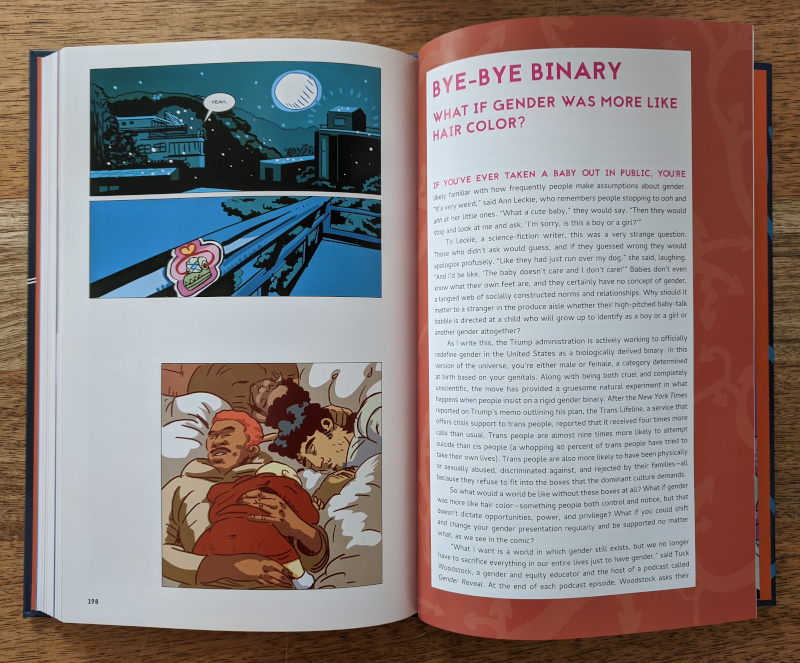
Each comic about a possible (or impossible) future is accompanied by a short essay that explores the topic further. (Credit: Rose Eveleth (text) / Ziyed Y. Ayoub (art). Fair use.)
It’s a book about the future, but it’s firmly grounded in the social and political discussions of the present. For example:
-
In “Welcome to Tomorrowville”, artist Ben Passmore and Eveleth wonder how the biased algorithms of a “smart” city might reinforce historical patterns of racism and marginalization.
-
In “Never Lay Me Down to Sleep”, Matt Lubchansky portrays a world in which we can fully conquer sleep with pills, and the inevitable exploitation of workers that follows.
-
In “Unreel”, Chris Jones and Zach Weinersmith tell the story of a man who controls the world through deepfakes—initially with honest motives.
As with an anthology, the art, stories, and topics chosen will surely resonate differently with each reader. Some stories felt a little too stuck in the present to give me much to mull over (the animal rights story stands out to me here); others were a bit predictable (sleep is indeed important). It’s hard to explore questions of morality without getting preachy, and the book does not always succeed at it.
But whether in book or podcast form, Flash Forward is an engaging approach to thinking about the future, and I recommend it. It also helped me discover the work of artists I would otherwise not have known about. I’d love to see another volume, featuring new artists and new futures to chew on.
Are we born with brains that are blank slates waiting only to be filled with experience? And if so, why is it so difficult to simulate that same experience in a computer? Why can a sophisticated AI be easily tricked into thinking that a cat is guacamole or that a Granny Smith apple is an iPod? How have human brains managed to adapt to the diversity of environments across the globe, from the Stone Age to the Space Age?
In How We Learn: Why Brains Learn Better Than Any Machine … for Now, French neuroscientist Stanislas Dehaene shows that the “blank slate” hypothesis does not withstand scrutiny. Our brains are equipped, from birth, with specialized neural circuits that shape a child’s intuitions about physics, arithmetic, geometry, and probability.
Dehaene cites a large body of research (including his own) that shows how young infants’ brains make sense of the world using this “core knowledge”. This research has forced a re-appraisal of older psychological models that have become popular wisdom:
Incidentally, these results overturn several tenets of a central theory of child development, that of the great Swiss psychologist Jean Piaget (1896–1980). Piaget thought that young infants were not endowed with “object permanence”—the fact that objects continue to exist when they are no longer seen—until the end of the first year of life.
He also thought that the abstract concept of number was beyond children’s grasp for the first few years of life, and that they slowly learned it by progressively abstracting away from the more concrete measures of size, length, and density.
In reality, the opposite is true. Concepts of objects and numbers are fundamental features of our thoughts; they are part of the “core knowledge” with which we come into the world, and when combined, they enable us to formulate more complex thoughts. [p. 58]
Brains vs. Machines
Like a budding scientist, an infant’s brain forms predictions about the world and then adapts its wiring based on whether the predictions match reality. This neuroplasticity is powerful, but it is highest during early sensitive periods, and dependent on innate cognitive skills—a number sense, the ability to detect faces, to acquire languages, and so on.
Dehaene contrasts this with the current generation of artificial networks, which are closer to a “blank slate” on which the characteristics of a training dataset are gradually inscribed. As a result of this naive approach, AIs lack the human brain’s multifaceted reasoning skills—”for now”, as the book’s subtitle puts it.
Hinting at what tomorrow may bring, Dehaene cites examples of artificial neural networks modeled after human cognition. For instance, a 2008 algorithm for predicting the optimal structural representation of various datasets “rediscovered” human knowledge representations like the tree of life.
One may quibble with the author’s assertion that human brains learn “better” than machines, given that the latter have already excelled in specific domains. Just ask Go player Lee Sedol, who retired from professional play and called AI “an entity that cannot be defeated”.
A Theory of Learning
But the focus of the book are humans, not machines. The author’s goal is nothing less than a theory of learning that teachers, parents, and students can apply in practice. He suggests a model based on “four pillars of learning”: attention, active engagement, error feedback, and consolidation.
From these four pillars he develops concrete recommendations for educators. Many of them may match the instincts of progressive teachers: anxiety and stress prevent learning; students need to be engaged as individuals; sleep is essential. However, Dehaene is highly critical of unassisted discovery learning and the popular idea of learning styles.
Dehaene does not take a one-sided view in the “nature versus nurture” debate; instead, he explains the complex interplay between our biology and the world we inhabit. Biological evolution has placed constraints on us, but it has also allowed us to reason about the workings of our own brains, and to journey to other planets.
The Verdict
As a whole, I highly recommend Dehaene’s book. As befits the subject, he is a great (occasionally witty) teacher who uses straightforward explanations and illustrations in order to systematically advance the reader’s understanding of a complex subject.
While I found the author’s level of certitude—when he talks about animal intelligence or learning styles, for example—a bit off-putting at times, that too can be the mark of a teacher in love with their subject. It is a passion he successfully passes on to the reader.
If On A Winter’s Night, Four Travelers is a gift—literally. The indie game by Laura Hunt and Thomas Möhring is completely free, but you could easily mistake it for a commercial title. Its pixel art compares favorably both to classic point and click adventure games by LucasArts, and to modern ones like Kathy Rain. Möhring’s other credits include stunning concept art for the Netflix show The Queen’s Gambit, and each scene in the game feels like a small work of art in its own right.
The four titular travelers meet at a masquerade ball that takes place on a train in the late 1920s. Most of the story is told through flashbacks in which you experience a defining episode in the life of one of them. Behind their masks are troubled souls—as the player, can we only experience their stories, or change them? Like Italo Calvino’s book that inspired the game’s title, the game suggests that we interrogate it, not merely consume it.
This is not a lighthearted romp—think I Have No Mouth, But I Must Scream, not Monkey Island. You’ll be confronted with themes like mental illness and homophobia, and with graphic depictions of violence. Hunt and Möhring invite us to put on a mask and imagine the lives of these characters, whose worlds come alive in the game’s art and music. For the soundtrack, the developers have drawn on freely available recordings of classical music and songs from the depicted era.
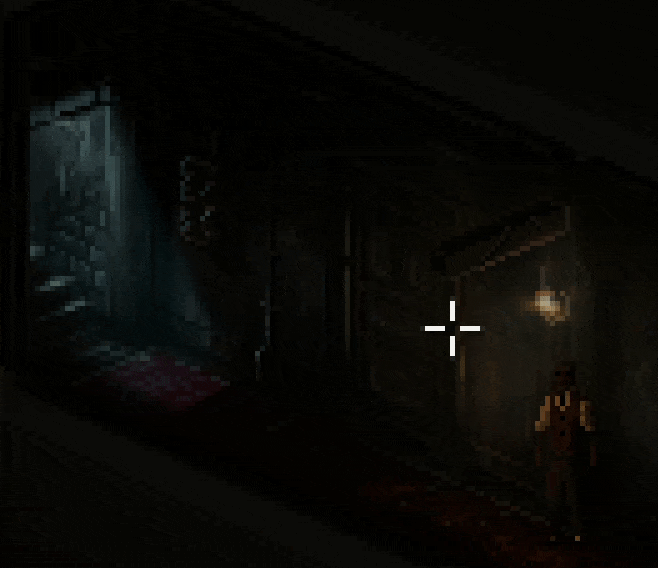
Lighting effects and subtle animations make even small scenes, like this brief encounter in a hallway, highly memorable. (Credit: Laura Hunt and Thomas Möhring. Fair use.)
There are small puzzles you have to solve to advance in the story, but none are likely to stump you for very long. That’s in part because there’s no inventory—you occasionally have to pick up an item, but you then immediately use it elsewhere in the scene. It’s point and click reduced to its essence.
With these simple mechanics, the game achieves surprising depth. For example, in the first story, you choose whether to interpret a telegram you have received from a lover positively or negatively. Depending on your choice, many subsequent interactions and observations will be different. In another story, you have to pay attention to sounds and voices instead of hunting for pixels.
Hunt and Möhring have made it clear that they do not want to be paid for the game, but they have suggested that an artbook and soundtrack may become available for purchase at a later date. If On A Winter’s Night, Four Travelers, then, is like a book you can pick up at any time from the library called the Internet. If you’re in the mood for a story that shows a little more darkness than light, I strongly encourage you to check it out.
Since the ascent of “casual” gaming, the explosion of online game publishing, and the rise of esports, video games have become mass culture for people of all ages. It’s only natural then to come across books like 1001 Video Games You Must Play Before You Die. The title a suggests grand curatorial ambition which the book never quite realizes.
It covers games across all devices and is organized chronologically, starting in 1971 (The Oregon Trail) and ending in 2013 (Bioshock Infinite). The book inexplicably focuses the bulk of its attention on titles from the 2000s (pages 416 to 921). So, prepare to read lots about the various Grand Theft Auto titles and Guitar Hero type games. On the other hand, Sierra Online’s entire catalog of adventure games is reduced to a single title (The Beast Within: A Gabriel Knight Mystery).
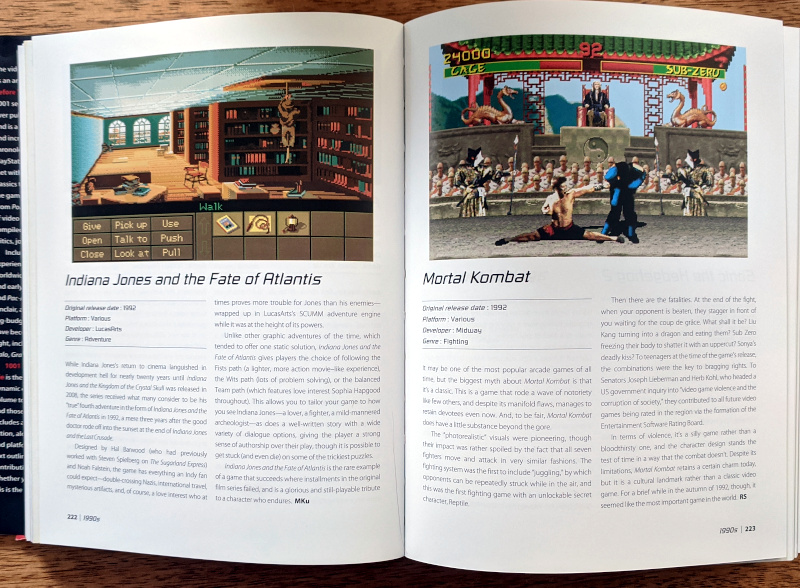
Most games in the book are as lavishly illustrated as the ones visible here. Some reviews, however, are entirely without screenshots. (Credit: Universe Publishing / Quintessence Editions Ltd. Fair use.)
The reviews of each title include plenty of criticism (sometimes so much that one has to wonder why the game made the cut at all), but no scores. With a large number of contributing writers, the quality of the writing is inconsistent. Some authors do an excellent job capturing a game’s ambience, story and gameplay; others barely describe the game at all, dwelling instead on development history and other minutiae.
My biggest frustration was that some games were included without any screenshots whatsoever—and we’re not talking about text adventures here, but titles like Elite or Nintendogs. This is the exception, but it’s still a cardinal sin for this kind of book, and the reason I can only give it three stars.
All in all, I don’t regret keeping this hefty compendium on my shelf, but if you’re looking for video game curation done well (with a lot more love for older games), I would recommend checking out the many titles by Bitmap Books instead.
So, what is your robot going to look like? Will it be a box with eyes on wheels, a flying furry puppet, a spider-robot with 360-degree vision? Make your selection and be presented with—another screen of text.
Choice of Robots is a game by Choice of Games, a company that should not exist. At least not if gaming followed the conventional history in which video game genres are forged in the fire of one generation of computing hardware, only to be wiped out in the avalanche of the next. Text adventures? They have gone the way of the dodo and the cathode-ray tube, surely.
Not quite. In 2009, Choice of Games released “Choice of the Dragon”, a text-based adventure game that became a smash success on mobile devices. Since then, they have released more than 100 titles under the “Choice of” label. The company has also made its game engine available under a license that permits noncommercial use, and they publish an endless flow of user-created titles.
It’s hard to explain the appeal of “Choice of” games if you haven’t played one. So go ahead, and try the damn dragon game in your browser. While the games share similarities with “Choose Your Own Adventure” gamebooks (“to attack the dragon, turn to page 69”), they offer a much larger number of choices, track internal variables, and do other things that computers can and books can’t. One thing they don’t do: trying to parse text input (“GET LAMP”). If you’ve ever played an old school text adventure, the parser is the one thing likely to drive you bonkers, because typing the exact words the computer expects can be a stochastic nightmare.

Just a few paragraphs of text, next choice. A bit more text, next choice. The formula works beautifully to get you to read a book without realizing it. (Credit: Choice of Games / Kevin Gold. Fair use.)
Robots then! Choice of Robots author Kevin Gold knows 01 thing or 10 about them. An Assistant Teaching Professor at Northeastern University, he “received his PhD from Yale University in 2008 for research on how robots could learn the meanings of pronouns and other abstract words from examples.” Choice of Robots isn’t about pronouns, though—it’s more about fulfilling that fantasy of “conquering Alaska with your robot army” that you’ve always had. OK, you also do get to pick your robot’s pronouns.
You start the game designing your robot and then walk down your chosen path, to achieve your destiny as a reclusive robot tinkerer or a power-mad corporate overlady. Yes, those are the only two options. Just kiddding.
The game beautifully adapts to your decisions. If you want your Alaska fantasy, that’s what you’ll get (hey, no judgment). If you want a love story, that’s what you’ll get. If you want a tale in which hyperintelligent robots become good-natured shepherds of their obsolete human builders, that’s probably also what you’ll get, but ask your robot supervisor.
Aside from the romantic options being fairly limited—this ain’t a robot dating sim—none of these paths feel underdeveloped. Gold’s writing draws upon the real world (let your professor introduce you to the military-industrial complex), on myths and legends (dress up as Hephaestus at a party), on literary references (quote The Tempest at a funeral), and much more. It does so while staying lighthearted and unpretentious, even as Gold’s PhD ever looms in the game’s byline.
Choice of Robots may make you think about what the future holds, but most of the philosophical ground it visits is well-traveled. It’s in the nature of the game to not be morally prescriptive. In other words, you can be clearly quite evil, if that’s how you want to play it. As an interactive story, it’s a masterclass that’s sure to keep you entertained for a few hours. To send your flying muppet into the world, it’s well worth the six bucks.
The Last Birdling is a visual novel by indie developer Marcus “InvertMouse” Lam released in 2017, two years after Cursed Sight (review). It tells the story of the secretive relationship between two girls, a human named Tayo and a birdling named Bimonia. The birdlings are winged humanoid creatures that once dominated the wild—but after a great war with the humans, Bimonia and her mother may be the last birdlings alive.

As a young woman, Tayo is drawn further into the conflict between birdlings and humans. (Credit: InvertMouse. Fair use.)
A a child, Tayo befriends Bimonia in the forest near a human settlement. For both girls, their growing friendship is a chance to escape their protective and demanding mothers, and to experience the joy of discovering the world through the eyes of another. But humans still view birdlings as dangerous monsters. If Bimonia is spotted by the townspeople, the result will almost certainly be bloodshed—and Tayo will be branded a traitor for becoming a birdling’s friend.
As the player, your perspective alternates between the two protagonists, and you are prompted to make many small choices. As Tayo, do you swallow a rotten herb offered to you by Bimonia, even though it may make you ill? The effect of these choices is limited until the end, when the nature of the relationship between Tayo and Bimonia leads to one of five endings.
Regardless of your decisions, this is not a cheerful tale. While the game is generally not visually explicit, it includes textual descriptions of violence, death, and sexual assault.
A well-crafted tale
Technologically, The Last Birdling is a solid title that showcases InvertMouse’s growing mastery over the visual novel format. The characters are visually expressive and the game is well-paced, offering beautiful chapter transition screens as the story progresses. As a player, it’s easy to visit the different endings without re-reading old text.
The game attempts a fair bit of worldbuilding, including a glossary that fleshes out concepts touched upon in the story. The quality of the writing is sometimes uneven, but never distractingly so. As in some of InvertMouse’s other stories, the characters do have a tendency towards self-loathing that gets a bit tiresome.
The Last Birdling is a better title than Cursed Sight in almost every respect, but in spite of that, I found it less emotionally impactful. The ambiguous relationship between Bimonia and Tayo pulled me away from the characters to the larger themes of the story. As a result, even the most tragic events packed less of a punch.
Nonetheless, The Last Birdling is a good story. I would recommend it to fans of the visual novel genre, if you’re in the mood for a fantasy tale about forbidden friendship that visits some dark places. At $5 it’s a small price for a labor of love by a storyteller of maturing talent.
In Arrival of the Fittest (review), biologist Andreas Wagner made the compelling argument that life “finds its way” to solutions by way of neutral mutations. Through incremental changes, proteins can change shape gradually without losing their original function. As a population diversifies, natural selection can then identify those protein variants that have acquired entirely new, useful functions.
The book challenged a naive view of evolution, in which the vast majority of genetic mutations cause harm, and a small percentage of them confer an immediate survival benefit. The truth is that life needs to “play around” with neutral mutations to navigate the landscape of possible changes that may make a species more or less suited for survival.
In Life Finds a Way, Wagner applies this “landscape thinking” to all types of creative problem-solving. The first half of the book focuses on the concept of fitness landscapes, a limited but useful visual metaphor for how well-adapted specific genes (and the creatures they inhabit) are to their environment. The peaks in a three-dimensional landscape represent high levels of successful adaptation to the environment:
Visualization of a population of individuals evolving to become better suited for survival, i.e. “climbing a peak” in the fitness landscape. (Credit: Randy Olson and Bjørn Østman. License: CC-BY-SA.)
Natural selection marches steadily uphill. What prevents a population from being trapped on a small hill that represents an evolutionary dead end, an adaptation of limited usefulness that can’t be improved? Wagner breaks down how genetic drift (changes in frequency of specific gene variants), genetic recombination through sexual reproduction, and horizontal gene transfer in bacteria help individuals in a population slide or jump across the fitness landscape.
Wagner shows how potential energy landscapes in physics can similarly be used to map the possible configurations of molecules or crystals, and how gravity, thermodynamics and other physical forces push nonliving matter into stable (and often beautiful) configurations that represent valleys in the landscape.
Of mountains and molehills
In the second half of the book, Wagner applies landscape thinking to human creativity. He encourages us to visualize the map of creative solutions to a given problem (even if that “problem” is the composition of beautiful music) as a landscape with peaks and valleys. What does it take for a creative mind to climb mountains and avoid getting stuck on molehills of mediocrity?
The author enumerates many tools creative minds can use to traverse the landscape of ideas without getting stuck, including:
-
dreams
-
play
-
travel and exposure to other cultures
-
work with people from other disciplines
-
drugs.
As a positive model for cross-disciplinary work, Wagner cites the Santa Fe Institute, a renowned cross-disciplinary think tank where Wagner is an External Professor. (One way I hope they won’t be a model: even though the institute was only founded in 1984, its seven founders were all men, something Wagner does not remark upon.)
Into the badlands
Wagner harshly criticizes the obsession with standardized testing in the United States, and the rigid education approaches of South Korea and China. In his critique, he revisits familiar generalizations about “Western” and “Eastern” cultures, and seems to see “Eastern” cultures trapped in rigid uniformity, while situating the pinnacle of individual freedom in the United States.
Nations that want to nurture creative minds, Wagner argues, should reduce the negative consequences of failure—whether it’s for scientists applying for a research grant, or for entrepreneurs starting a business. Creative societies should be accessible to immigrants with diverse backgrounds, and recognize the benefits of diversity and individual freedom.
While Wagner pays lip service to the dangers of inequality, his analysis is stuck in a neoliberal frame of reference. Much more could be written about how an effective welfare state, a vibrant democracy, and alternatives to exploitative capitalism and intellectual monopoly rights (copyright, patents, etc.) are necessary to reap the benefits of human creativity for all people.
Instead, Wagner repeatedly cites Silicon Valley as an example for innovation, with the implicit assumption that the way to make a better world is to create more corporations like Facebook, Apple, and Tesla.
It’s worth remarking that Life Finds a Way was written before the COVID-19 crisis laid bare the utter incompetence of many “Western” governments, including the United States, in managing a pandemic. The landscape of ideas about COVID-19 is dotted with the creative edifices built by anti-vaxxers and ideologues, and landscape thinking alone seems like a very limited tool for getting humanity out of the badlands.
Thankfully, Wagner’s flurry of societal prescriptions is as brief as it is unimaginative. What we’re left with, then, is his argument to apply landscape thinking beyond physics and biology, providing an intellectual foundation for the value of letting our minds roam. That’s all it is—a foundation, one which I do hope other writers will build on.
